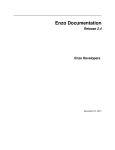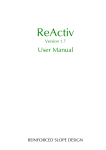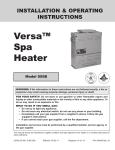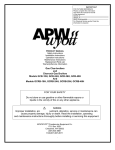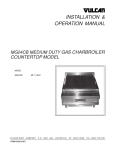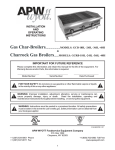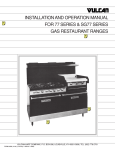Download Vulcan-Hart VTEC25 Unit installation
Transcript
OPERATING, INSTALLATION, SERVICE & PARTS MANUAL FOR MEDIUM DUTY GAS CHAR BROILERS MGB-A SERIES VULCAN-HART FORM 990503 (09-88) COMPANY, P.O. BOX 696, LOUISVILLE, KY 40201-0696, TEL. (502) 7 7 8 - 2 7 9 1 MGB-A OPERATING, INSTALLATION, SERVICE & PARTS ! IMPORTANT OPERATING, INSTALLATION AND SERVICE PERSONNEL Operating information for this equipment has been prepared for use by qualified and/or authorized operating personnel. All installation and service on this equipment is to be performed by qualified, certified, licensed and/or authorized installation or service personnel, with the exception of any marked with a in front of the part number. Service may be obtained by contacting the Factory Service Department, Factory Representative or Local Service Agency. DEFINITIONS QUALIFIED AND/OR AUTHORIZED OPERATING PERSONNEL Qualified or authorized operating personnel are those who have carefully read the information in this manual and are familiar with the equipment’s functions or have had previous experience with the operation of the equipment covered in this manual. QUALIFIED INSTALLATION PERSONNEL Qualified installation personnel are individuals, a firm, corporation or company which either in person or through a representative are engaged in, and are responsible for: 1. The installation of gas piping from the outlet side of the gas meter, or the service regulator when the meter is not provided, and the connection and installation of the gas appliance. Qualified installation personnel must be experienced in such work, be familiar with all precautions required, and have complied with all requirements of state or local authorities having jurisdiction. Reference in the United States of America - National Fuel Gas code ANSI Z223.1 (Latest Edition) In CanadaCanadian Standard CAN1-B149.1 NAT. GAS (Latest Edition) or CAN1-B149.2 PROPANE (Latest Edition). 2. The installation of electrical wiring from the electric meter, main control box or service outlet to the electric appliance. Qualified installation personnel must be experienced in such work, be familiar with all precautions required, and have complied with all requirements of state or local authorities having jurisdiction. Reference: In the United States of America-National Electrical Code ANSI NFPA No. 70 (Latest Edition). In Canada-Canadian Electrical Code Part 1 CSA-C22.1 (Latest Edition). QUALIFIED SERVICE PERSONNEL Qualified service personnel are those who are familiar with Vulcan equipment who have been endorsed by the Vulcan-Hart Corporation. All authorized service personnel are required to be equipped with a complete set of service parts manuals and stock a minimum amount of parts for Vulcan equipment. SHIPPING DAMAGE CLAIM PROCEDURE For your protection, please note that equipment in this shipment was carefully inspected and packed by skilled personnel before leaving the factory. The transportation company assumes full responsibility for safe delivery upon acceptance of this shipment. If shipment arrives damaged: 1. VISIBLE LOSS OR DAMAGE — Be certain this is noted on freight bill or express receipt and signed by person making delivery. 2. FILE CLAIM FOR DAMAGES IMMEDIATELY — Regardless of extent of damage. 3. CONCEALED LOSS OR DAMAGE — If damage is unnoticed until merchandise is unpacked, notify transportation company or carrier immediately, and file “concealed damage” claim with them. This should be done within (15) days of date of delivery is made to you. Be sure to retain container for inspection. We cannot assume responsibility for damage or loss incurred in transit. We will, however, be glad to furnish you with necessary documents to support your claim. PLEASE RETAIN THIS MANUAL FOR FUTURE REFERENCE –2– MGB-A OPERATING, INSTALLATION, SERVICE & PARTS IMPORTANT NOTES FOR ALL VULCAN APPLIANCES 1. These units are produced with the best possible workmanship and material. Proper installation is vital if best performance and appearance are to be achieved. Installer must follow the installation instructions carefully. 2. Information on the construction and installation of ventilating hoods may be obtained from the “Standard for the installation of equipment for the removal of smoke and grease laden vapors from commercial cooking equipment,” NFPA No 96 (latest edition) available from the National Fire Protection Association, Battery March Park, Quincy MA 02269. 3. For an appliance equipped with a flexible electric supply cord, the cord is equipped with a three prong (grounding) plug. This grounding plug is for your protection against shock hazard and should be plugged directly into a properly grounded three prong recepticle. Do not cut or remove the grounding prong from this plug If the appliance is not equipped with a grounding plug, and electric supply is needed, ground the appliance by using the ground lug provided (refer to the wiring diagram). (FOR GAS APPLIANCES ONLY) 4. Do not obstruct the air flow into and around the appliance. This air flow is necessary for proper combustion of gases and for ventilation of the appliance. Provisions for ventilation of incoming air supply for the equipment in the room must be in accordance with National Fuel Gas Code ANSI Z223.1 (latest edition). 5. Do not obstruct the flow of flue gases from the flue duct (when so equipped) located on the rear (or sides) of the appliance. It is recommended that the flue gases be ventilated to the outside of the building through a ventilation system installed by qualified personnel. 6. For an appliance equipped with casters, (1) the installation shall be made with a connector that complies with the Standard for Connectors for Movable Gas Appliances, ANSI Z21.69 (latest edition), and Addenda, Z21.69a (latest edition), and a quick-disconnect device that complies with the Standard for Quick-Disconnect Devices for Use With Gas Fuel, ANSI Z21.41 (latest edition), and Addenda, Z21.41a (latest edition) and Z21.41b (latest edition), and (2) adequate means must be provided to limit the movement of the appliance without depending on the connector and the quick-disconnect device or its associated piping to limit the appliance movement. If disconnection of the restraint is necessary, reconnect this restraint after the appliance has been returned to its originally installed position. 7. The appliance and its individual shutoff valve must be disconnected from the gas supply piping system during any pressure testing of that system at test pressures in excess of 1⁄2 psig (3.45 k Pa). 8. The appliance must be isolated from the gas supply system by closing its individual manual shutoff valve during any pressure testing of the gas supply system at test pressures equal to or less than 1⁄2 psig (3.45 k Pa). CAUTIONS FOR YOUR SAFETY DO NOT STORE OR USE GASOLINE OR OTHER FLAMMABLE VAPORS AND LIQUIDS IN THE VICINITY OF THIS EQUIPMENT OR ANY OTHER APPLIANCE. 1. KEEP THE APPLIANCE FREE AND CLEAR FROM ALL COMBUSTIBLE SUBSTANCES. 2. IN THE EVENT A GAS ODOR IS DETECTED, SHUT UNIT(S) DOWN AT THE MAIN SHUTOFF VALVE AND CONTACT THE LOCAL GAS COMPANY OR GAS SUPPLIER FOR SERVICE. 3. POST IN A PROMINENT LOCATION, INSTRUCTIONS TO BE FOLLOWED IN THE EVENT THE SMELL OF GAS IS DETECTED. THIS INFORMATION MAY BE OBTAINED FROM A LOCAL GAS SUPPLIER. –3– MGB-A OPERATING, INSTALLATION, SERVICE & PARTS MEDIUM DUTY GAS CHAR BROILER - OPERATING, INSTALLATION, SERVICE AND PARTS MANUAL INDEX Your Medium Duty Gas Char Broiler is produced with the best possible workmanship and material. Proper usage and maintenance will result in many years of satisfactory performance. The manufacturer suggests that you thoroughly read this entire manual and carefully follow all of the instructions provided. DESCRIPTION PAGE DEFINITIONS OF PERSONNEL (Operating, Installation & Service) and SHIPPING DAMAGE CLAIM PROCEDURE (Inside Front Cover) IMPORTANT NOTES 3 INDEX 4 A. PREPARING FOR INSTALLATION 5 B. GAS SUPPLY 5 C. LIGHTING AND ADJUSTMENT 6-7 D. SERVICE 8 E. REPLACEMENT PARTS LIST— MGB-A 9-11 F. OPERATING AND MAINTENANCE 12 –4– MGB-A OPERATING, INSTALLATION, SERVICE & PARTS A. PREPARING FOR INSTALLATION 1. Carefully open carton. Lift foam packing material and protective plastic covering. 2. Remove packing bag containing adjustable legs, from inside carton. 3. Lift the appliance out of carton. 4. Lift the grates and radiants out of carton. 5. The broiler shipped as a complete unit, and does not require field assembly except the supporting legs, crates and Radiants. Screw the legs on four corners of the unit, into permanently fastened nuts. Hand tighten the legs and set unit in place. Turn adjustment screw at bottom of leg, to level unit. 6. Place unit in location it is to occupy, and pipe gas supply to unit. Be sure gas supply and gas type, as shown on unit name plate, agree. Unit installation must conform with the National Fuel Gas Code, ANSI Z 223.1.1984 (copies may be obtained from American Gas Association, 1515 Wilson Blvd., Arlington, Va. 22209) and in accordance with applicable local codes. Unit requires front clearance of 32 inches minimum for proper servicing and operation. CAUTION: The unit must only be installed in fire resistive locations. Suitable and fire-safe provisions must be made to exhaust the fumes which will rise from the food being broiled. In the absence of local codes, installation must comply with ANSI/NFPA 96-1980. B. GAS SUPPLY 1. Pipe gas supply to unit installation of a manual shut-off valve (supplied with the unit) in supply line is mandatory to permit complete shut-down of unit for service. Following precautions must be observed. (a) Check that the type of gas supply agrees with the type of gas indicated on the rating plate. The rating plate is located on the inside of front panel. (b) Pipe joining sealing compound used must be resistant to action of L.P. (Liquified Petroleum) gases. (c) Check pipe joints for gas leaks with soap solution. CAUTION: Do not use an open flame to check for leaks. (d) The appliance and its individual shutoff valve must be disconnected from the gas supply piping system during any pressure testing of that system at test pressures in excess of 1⁄2 psig (3.45 kPa). –5– (e) The appliance must be isolated from the gas supply piping system by closing its individual manual shutoff valve during any pressure testing of the gas supply piping system at test pressures equal to or less than 1⁄2 psig (3.4566 kPa). 2. All units are equipped with fixed orifices for use with Natural or Propane Gas, and no adjustments necessary. 3. Units for operation on Natural or Propane Gas, are also equipped with a factory preset pressure regulator with an outlet pressure of 3.7". Water Column for Natural Gas supply, and 10" Water column for Propane Gas Supply; and should not require further adjustment. MGB-A OPERATING, INSTALLATION, SERVICE & PARTS C. LIGHTING AND ADJUSTMENT 3. MAIN BURNER AIR SUPPLY 1. Lighting instructions are inside the front panel. To open the panel to reach the manifold. For efficient burner operation, it is important that a proper balance of gas volume and primary air supply is maintained, resulting complete combustion. Insufficient air supply results in a yellow streaming flame. Check flames with control knob turned to “HI”, and radiants and top grates removed. Primary air supply is controlled by air shutter on front of the burner. a. Remove thumb screws from upper front panel, lift upper front panel until it clears the lower front panel. b. To install the upper front panel, place panel above lower front panel, slip upper panel down so it engages lower front panel. 2. LIGHTING PILOT: If the pilot goes out, an automatic shut-off valve turns off the gas supply to the burners. To relight the pilot follow procedure. Loosen the hexagonal head screws on front of the burner, and adjust the air shutter to obtain a sharp flame without lifting. Lock the air shutter in place tightening the screws. Repeat this procedure with all burners. a. Turn the control valve to “off”. Wait a sufficient length of time to allow gas which may have accumulated in the burner compartment to escape (at least five minutes). b. Turn on the main shut-off valve. c. Depress and hold in on the red button “A” on the automatic shut-off valve while lighting the pilot burner. d. When gas at pilot has been running for about 45 seconds, release the red button. If pilot does not remain lighted, repeat the operation allowing more time before releasing red reset button. Do not permit fans to blow directly at the unit and wherever possible avoid open windows next to the unit sides and back. Avoid wall type fans which create air cross currents within the room. It is also necessary the sufficient air should be allowed to enter the room to compensate for the amount of air removed by any ventilating system. Otherwise, a subnormal atmosphere pressure will occur, affecting operation adversely and causing undesirable conditions. A properly designed and installed hood will act as the heart of the ventilating system for the room or area in which the unit is installed, and will leave the unit independent of changing draft conditions. FIGURE 1 e. To adjust the pilot flame, remove pilot adjustment cap “B” (Figure 1) to expose the adjusting screw. Rotate the adjusting screw clockwise to reduce the gas flow; and counterclockwise to increase the gas flow, to provide a properly sized pilot flame (approximately 1⁄2" to 3⁄4" long) Replace the adjustment cap “B”. –6– MGB-A OPERATING, INSTALLATION, SERVICE & PARTS C. LIGHTING AND ADJUSTMENT (Continued) 4. RADIANTS 5. GRID GRATES Place the radiants in their position as shown in Figure 2. Make sure that radiants nestle properly on front and rear supports. Place the top grid grates in place with the grid bars sloping toward the front as shown in Figure 3, or with grid bars horizontal. These two positions can be obtained by turning the grid grates upside down. NOTE: Do not drop radiants on supports. NOTE: When grid grates are placed sloping toward the front, groves on top will guide excess fat drippings into the grease trough. 6. EXTENDED SHUTDOWN Turn the manual shut-off valve to “off” position and shut off the pilot flame by turning the adjusting screw on the pilot valve. –7– MGB-A OPERATING, INSTALLATION, SERVICE & PARTS D. SERVICE 1. In order to remove burner for cleaning or replacement: (a) Remove the top grates (b) Remove the radiants (c) Remove the burners (d) Reverse procedure for reassembly 2. To remove burner drawer: (a) Turn off main shutoff valve (b) Disconnect union (c) Remove burner drawer screws, slide burner drawer forward. SERVICE TROUBLE SHOOTING GUIDE PROBLEM POSSIBLE CAUSE WHEN HEAT DOES NOT COME ON WHEN CONTROL VALVE IS TURNED-ON GAS VALVE BAD PILOT BURNER NOT LIT PILOT BURNER WILL NOT LIGHT MANUAL OR SAFETY SYSTEM GAS SYSTEM GAS VALVE NOT TURNED ON OBSTRUCTED PILOT ORIFICE PILOT GAS TURNED OFF AT AUTOMATIC PILOT VALVE AUTOMATIC VALVE BAD PILOT BURNER WILL NOT STAY LIT THERMOCOUPLE BAD THERMOCOUPLE NOT HOT ENOUGH OBSTRUCTED OR WRONG SIZE PILOT ORIFICE GAS SUPPLY NOT PURGED OF AIR AIR BLOWING PILOT OUT AUTOMATIC PILOT VALVE BAD –8– MGB-A OPERATING, INSTALLATION, SERVICE & PARTS E. REPLACEMENT PARTS LIST — MGB-3A, 4A, 5A OR 6A 1. 2. 3. 4. 5. 6. 7. 8. 9. 10. 11. 12. 13. 14. 15. 16. 17. 18. PART NO. DESCRIPTION QTY. 804133 804132 820133 820133-1 820134-1 820134 920313 920331-11 OR 920331-12 920325 805921-13 920601 920442 920669-11 OR 920669-12 802389-18 OR 802389-15 802389-22 802389-27 802389-28 820312 820118 820322 820118-1 820309 804405 920573-1 TOPGRID RADIANT “S” BURNER 3A, 6A & 5A R.H. “S” BURNER 6ALH. “U” BURNER 4A&5AL.H. “U” BURNER 4A R.H. PILOT BURNER PILOT BURNER ORIFICE (NAT) 3 or 4 or 5 or 6 3 or 4 or 5 or 6 1 1 1 1 1 1 PILOT BURNER ORIFICE (PROP) THERMOCOUPLE HI-LOW CONTROL VALVE MANUAL SHUT OFF VALVE AUTOMATIC PILOT VALVE PRESSURE REGULATOR (NAT) 1 1 1 or 2 1 1 1 PRESSURE REGULATOR (PROP) #31 BURNER ORIFICE FITTING (NAT) 3A & 6A 1 1 or 2 #51 BURNER ORIFICE FITTING (PROP) 3A, 5A & 6A #41 BURNER ORIFICE FITTING (NAT) 4A & 5A #54 BURNER ORIFICE FITTING (PROP) 4A & 5A #32 BURNER ORIFICE FITTING (NAT) 3A, 5A & 6A GREASE TRAY ASSY. 3A, 5A, 6A TRAY HANDLE 3A,5A,6A GREASE TRAY ASSY. 4A TRAY HANDLE 4A CONTROL VALVE KNOB ADJUSTABLE FOOT WIRE BRUSH ASSY. 1 or 2 1 or 2 1 or 2 1 or 2 1 or 2 1 or 2 1 1 1 or 2 4 1 NOTE: Order just the quantity of parts that need to be replaced. The plant is in the process of converting computer part records; to avoid confusion please specify both numbers. –9– MGB-A OPERATING, INSTALLATION, SERVICE & PARTS E. REPLACEMENT PARTS LIST — MGB-3A, 4A, 5A, 6A, Cont – 10 – MGB-A OPERATING, INSTALLATION, SERVICE & PARTS E. REPLACEMENT PARTS LIST — MGB-3A, 4A, 5A, 6A, Cont – 11 – MGB-A OPERATING, INSTALLATION, SERVICE & PARTS F. OPERATING AND MAINTENANCE 1. Since all burners are lit from constantly burning pilots, turn control knobs to “HI” to ignite the burners. (c) Place grates on broiler, with grid bars horizontal, facing down. 2. Turn control knobs to “HI” about 25-30 minutes before cooking time. After this period of pre-heat, grid temperatures will be in the range of 600° F. for best broiling results. The control knobs should then be adjusted to “LO” position to maintain the grid temperature between 575° F. and 625° F. (d) Turn control knobs to “HI” for approximately 45 minutes. NOTE: Do not leave the burners on, with knobs in “HI” position for any extended period of time beyond the recommended pre-heat time or “burn-off” time. 3. Always be careful when working on the broiler, because all areas will be hot. 4. In order to minimize gas usage, only those burners needed for cooking load need to be operated. 5. At least once a day, remove the grease pan, empty and wash it out in the same way you would any cooking utensil. Grease in the grease pan will not get hot enough to be ignited by burners. However, under some use conditions, flaming particles may drop into the grease drawer and cause it to ignite. Only if your use conditions warrant, add a 1/16 inch deep layer of water in the grease pan to prevent this from happening. (e) Turn off the broiler and allow it to cool for 20 minutes. (f) Clean top and bottom surfaces of grate with a wire brush to remove animal fats and carbonized grease. (g) Clean channels on grates with a scraper. (h) Remove grates from broiler. Clean top surface of radiants with the wire brush. They may be cleaned in place. 8. Once a Week: After completing step 7 (a) through (h), remove the radiants. Clean reflecting drip shield (Figure 3) of any dust or debris, with a brush. 9. NOTE: Top grid grates and radiants are heavy. They may break if dropped or bumped. 10. Burner air shutter openings must be kept clean. 11. Burner ports must be kept clean. To clean burners, boil them in a strong solution of lye water for fifteen to twenty minutes. Then, either brush with a wire brush or clean gas ports with a sharp pointed metal instrument to insure open ports. 6. Once a Week: Thoroughly clean the exposed surfaces of broiler-sides, front, and top grease trough, with a damp cloth, then polish with a soft dry cloth. A detergent may be used for cleaning. To remove discolorations, use a non-abrasive cleaner. Do not permit fans to blow directly at the unit and wherever possible avoid open windows next to the unit sides or back. Avoid wall type fans which create air cross currents within the room. 7. Grate “Burn Off”. The grease build-up on the grates should be cleaned daily or as dictated by use. Follow the procedure outlined in (a) through (h): All valves and thermostats must be checked and lubricated periodically. Check with your Service Agency. (a) CAUTION: When handling grates or radiants, always use insulated gloves to prevent burns. 12. In order to remove burners for cleaning replacement: (b) WARNING: Do not cover the top of the grid grates during a burn-off operation. Restricting the air flow by covering the grid grates, may cause them to wrap. (a) Remove the top grates (b) Remove the radiants (c) Remove the burners (d) Reverse procedure for reassembly – 12 – THIS PAGE INTENTIONALLY LEFT BLANK THIS PAGE INTENTIONALLY LEFT BLANK MANUAL PART NO.: 99-05-03A FOR MODELS: MGB-3A, 4A, 5A, 6A MEDIUM DUTY CHAR BROILERS DESCRIPTION: OPERATING, INSTALLATION, SERVICE AND PARTS MANUAL REV. BLOCK REV.# DATE SIGN 1 2 3 12/85 06/87 09/88 NWK VW VW THIS PAGE INTENTIONALLY LEFT BLANK

















